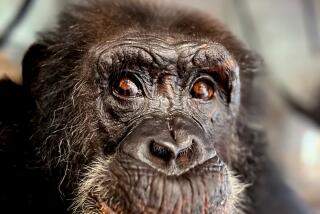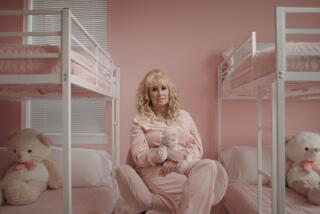Foster Home for Monkeys Is First Step in Effort to Aid Disabled : Medicine: Families who are picked to train capuchins to be helpmates for handicapped people find they are dealing with something near-human.
CLACKAMAS, Ore. — Nellie is a baby now, with diapers to be changed and bottles to be warmed. But in just four years, her foster parents will have to send her off into the world.
Nellie, a year-old capuchin monkey, is in training to become a helpmate to a quadriplegic.
“Think of what she’s going to do and how much entertainment she’s going to be to that person,” says Donna Tatom, 48, Nellie’s ward. “It makes all the trauma I’m going to have to go through all worthwhile, because I may never see her again.”
Nellie came to the Tatom family through Helping Hands: Simian Aides for the Disabled Inc., a Boston-based nonprofit organization.
The group trains monkeys to perform daily tasks: put a cassette in a recorder, fetch a book or place sandwiches or drinks onto a feeding tray. They then are placed with quadriplegics free of charge.
Mature capuchin monkeys weigh about 5 pounds and stand about 18 inches tall. They are intelligent, good at manipulating objects and have a relatively long attention span.
Before they can be trained, however, they must be socialized. When the monkeys are a few weeks old, they are given to foster families such as Tatom’s.
“With me, she has to learn to be potty trained, teaching her ‘no,’ socializing, things you would do with a child before he can go to kindergarten,” Tatom says. “She has to learn she has boundaries.”
Tatom applied for Nellie about five years ago with the support of her husband, Ken, 49, a captain in the Portland Fire Bureau, and sons, Rob, 27; Mark, 24, and Daniel, 22. She had worked with children who have muscular dystrophy and has an interest in helping the handicapped.
And, having been raised in rural Oregon, she has been around animals all her life. That is what made Nellie a surprise.
“I expected an animal, but I got a person,” Tatom says.
Nellie’s expressive hazel eyes, in a tiny pinkish face, widen like a child’s in surprise and delight. Her brow furrows with concentration. She puckers her face willfully when she frowns.
She reaches out for people with her arms outstretched and wraps her hand around a finger, like an infant. And she sucks her thumb.
The effect is startlingly human.
“You just in no way think of her as an animal, not when they can think and reason and use their hands and open and shut things and react,” Tatom says.
Nellie still is fed baby formula in a tiny bottle, but can drink water, slopping just a little, from her own cup. At just 4 pounds, 3 ounces, she wears tiny diapers cut from adult-sized socks.
She munches on Cheerios picked out of a cup. She also likes green grapes and watermelon, and celery and apples cut in small chunks. She loves ice cream.
She plays with blocks, her Fisher Price Busy Box and similar toys designed for 6- to 18-month-old children. She curls up to sleep with her favorite stuffed animal beneath a baby blanket.
Like a baby, she must be constantly supervised. The program requires foster mothers to spend at least 10 hours a day with their new monkeys.
“There’s no way you can take care of these little guys properly and work too,” says Oregon foster home coordinator Sherri McCall.
There are some differences. For example, capuchins enjoy grooming people: They delicately pick through hair or clothes looking for bugs.
“I’m amazed at some of the imprinted things,” Tatom says. “The primate type stuff is still there.
“When she sees an animal, her defenses are up. When she eats, she throws her head back . . . in the jungle, to keep the juices and things in, they have to keep their heads back. So it’s still there, even though she’s never been in a tree.”
Nellie was born in a cage at the Helping Hands breeding colony of about 70 monkeys on Discovery Island at Walt Disney World in Florida. The colony has produced nearly 100 offspring since the program began in January, 1988, according to Disney World spokeswoman Sarona Soughers.
The baby monkeys are flown to their foster homes.
“Girls come with a Minnie Mouse (stuffed toy), because they’re clinging, still really clinging at that point. And boys come with Mickey Mouse. And they just cling onto that until you get them home,” Tatom says.
Nine Helping Hands monkeys are growing up in Oregon and about 150 in foster homes nationwide, McCall says.
The application process is rigorous.
“They investigate, I think, closer than if you were applying to adopt a child,” Tatom says. “They went through my house with a fine-tooth comb, through my background, through all my friends.”
Helping Hands was founded by Dr. Mary Joan Willard, a behavioral psychologist at the Boston University School of Medicine, and occupational therapist Judi Zazula.
Willard was a research assistant to noted psychologist B. F. Skinner and suggested that Skinner’s behavior modification techniques might be used to train chimpanzees to assist the disabled. Skinner suggested capuchins, which are smaller, more fastidious cousins of the chimpanzee.
In November, 1979, the first capuchin aide, Hellion, was placed with Robert Foster, 22, of Watertown, Mass. Foster was paralyzed from the shoulders down in an auto accident at age 18.
Program officials say the pairing was a success. Sixteen more monkeys have since been placed with quadriplegics.
More to Read
Sign up for Essential California
The most important California stories and recommendations in your inbox every morning.
You may occasionally receive promotional content from the Los Angeles Times.










